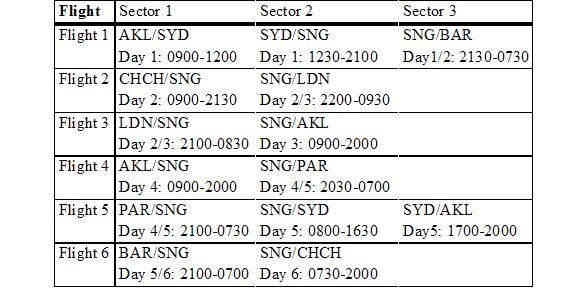Case Study: AirCrewRostering
Submitted: 20 Feb 2008
Operations Research Topics: IntegerProgramming
Application Areas: Rostering
Contents
Problem Description
Adapted from a real-world problem An airline is trying to roster captains for 6 flights. The flight schedules are: Only one captain is required for each sector, but a captain may be a passenger on a flight (this is called paxing). In addition to the six flights above the following flights are available for paxing and operate every 2 hours:
Only one captain is required for each sector, but a captain may be a passenger on a flight (this is called paxing). In addition to the six flights above the following flights are available for paxing and operate every 2 hours:
 The following rules for shifts must be observed:
The following rules for shifts must be observed:
- Shifts start and finish at a captain's home base;
- The earliest start time is on Day 1 (0001 hours) and the latest finish time is on Day 6 (2359 hours);
- Shifts are composed of blocks of work. Each block must be no more than 13 hours;
- Captains must have at least 12 hours break between blocks. The exception is when a block consists only of paxing flights, then a 9 hour break is all that is needed;
- There must be a 30 min break between sector changes.
Student Tasks
- Write a columnwise formulation to solve the Airline Rostering Problem. Generate feasible shifts for your formulation using any method you choose, be sure that your method generates all possible shifts. The spreadsheet airline_demo.xls shows some of the possible shifts. Solve the Airline Rostering Problem and write a management summary. Hint Using depth-first search or power sets in AMPL is difficult for this problem. Using a different programming language to generate the shifts, or generating them by hand using a carefully thought out method may be easier. What to hand in Your model file. A description of your shift generation method. Your management summary.
| I | Attachment | History | Action | Size | Date | Who | Comment |
|---|---|---|---|---|---|---|---|
| |
airline_demo.xls | r2 r1 | manage | 17.5 K | 2008-05-07 - 12:56 | TWikiAdminUser |
Topic revision: r12 - 2009-07-23 - CameronWalker
Ideas, requests, problems regarding TWiki? Send feedback



